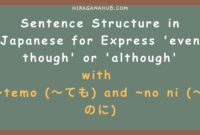Japanese Grammar: “Imasu” and “Arimasu”.
The Japanese language has a unique way of expressing the existence of things,
whether living beings or inanimate objects. To learn this, we will focus on
two essential verbs: imasu (います) and
arimasu (あります). This article will help you understand the
differences, formal and casual forms, and how to use them in daily
conversations.
The Difference Between Imasu and Arimasu
-
Imasu (います): Used to express the existence of living
beings such as humans or animals. -
Arimasu (あります): Used to express the existence of
inanimate objects, plants, or abstract things.

Formal and Casual Forms
Jараnеѕе has varying levels of politeness. Below are the formal and casual
forms of imasu and arimasu:
- Imasu:
Formal: imasu (います)
Casual: iru (いる)
- Arimasu:
Formal: arimasu (あります)
Casual: aru (ある)
Example Sentences Using Imasu
- ここにいぬがいます。
Koko ni inu ga imasu.: There is a dog.
- おかあさんはだいどころにいます。
Okaasan wa daidokoro ni imasu.: Mom is in the kitchen.
-
せんせいはきょうしつにいます。
Sensei wa kyoshitsu ni imasu.: The teacher is in the
classroom.
Example Sentences Using Arimasu
-
ここにじてんしゃがあります。
Koko ni jiten sha ga arimasu.: There is a motorbike.
-
リビングにテレビがあります。
Ribingu ni terebi ga arimasu.: There is a TV in the living
room.
-
れいぞうこにぎゅうにゅうがあります。
Reizouko ni gyuunyuu ga arimasu.: There is milk in the
refrigerator.
Example Conversations
Conversation 1: Looking for Someone
-
A: おとうさんはどこにいますか?
Otousan wa doko ni imasu ka?: Where is Dad?
-
B: みせにいます。
Mise ni imasu.: He is at the store.
Conversation 2: Asking About an Object
-
A: テレビはどこにありますか?
Terebi wa doko ni arimasu ka?: Where is the TV?
-
B: リビングにあります。
Zashitsu ni arimasu.: It is in the living room.
Conversation 3: Finding Something in the Refrigerator
-
A: れいぞうこにぎゅうにゅうがありますか?
Reizouko ni gyuunyuu ga arimasu ka?: Is there milk in the
refrigerator?
-
B: はい、あります。
Hai arimasu.: Yes, there is.
Vocabulary List
| Kanji | Hiragana | Romaji | Meaning |
|---|---|---|---|
| 犬 | いぬ | inu | Dog |
| 先生 | せんせい | sensei | Teacher |
| お母さん | おかあさん | okaasan | Mother |
| 台所 | だいどころ | daidokoro | Kitchen |
| 店 | みせ | mise | Store |
| 座室 | ざしつ | zashitsu | Living room |
| 冷蔵庫 | れいぞうこ | reizouko | Refrigerator |
| 牛乳 | ぎゅうにゅう | gyuunyuu | Milk |
| テレビ | てれび | terebi | TV |
| バイク | ばいく | baiku | Motorbike |
Using imasu and arimasu correctly is an
essential step in learning Jараnеѕе. By understanding their differences, you
can easily express the existence of people, animals, or objects. Practice the
example sentences above to improve your communication skills.
Don’t forget to keep learning with various Japanese language online lessons to
further develop your proficiency in Jараnеѕе !


